(The Swamp Thing Roundtable Part 1)
Context. It’s 1983 and you’ve just picked up the latest issue of your favorite monster magazine. You feel pretty stupid since Swamp Thing has sort of sucked since Bernie Wrightson stopped drawing it. That’s a nice cover by Thomas Yeates though.
Wasn’t he the guy who drew the first issue of Saga of the Swamp Thing a year back?
Remember. It is the age of innocence. The age of The Warlord and Arion. The age of stupidity. The age of bad taste.
Parker Brothers wants you to buy Q Bert.
You should have picked up that AD&D Video game…
…and the Power Lords are incontrovertibly essential.
And then you see this:
The land of milk and honey.
Nostalgia. I hate, it but it suffuses every pore of the creature that is called comics. Ask anyone beyond the gelatinous grasp of sequential art and hormonal surges what he or she feels about Swamp Thing #21 (“The Anatomy Lesson”) and they are likely to say: wordy, purple, unfrightening, average. Interesting art though.
But we know better. Alan Moore refined his craft in the pages of Warrior and 2000AD but this was the showcase event; an occurrence as important as the creation of the Swamp Thing himself.
[Original art from House of Secrets #92 with portrait of Louise Jones (Simonson)]
We can see so much of the older and wiser writer in these early issues. There’s the inscrutable narration; the prefiguration on the very first page, the panels acting as windows into the mind’s eye; a technique he would use to much greater effect many years later in the pages of From Hell (“A State of Darkness”).
And then there’s “American Gothic” (#37 to 50) – tired but significant for the superhero set. As subtle as a sledgehammer but undoubtedly influential in the way it caused a legion of Vertigo anti-heroes to take their own quaint road trips through the highways and byways of American culture and inbreeding.
Issue 38. John Constantine breaks a glass of Scotch, crumpling the shards in his palm as will Rorschach with the flesh of strangers. He struts around and plays Swampy for the innocent, gullible fool that he is. And he wears a trenchcoat. This is the same guy who will chill a room of beasties with a word and a glance in Neil Gaiman’s Books of Magic, the pale shadow who will get cancer and trick the devil in Garth Ennis’ “Dangerous Habits”. He’s as unchanging as the Christ, a surly, menacing Scouser with coat pockets brimming over with the occult and unspoken kindness. The shtick was getting old by the time Jamie Delano got his hands on him in the first issue of Hellblazer but he remains amiable enough. Such is the reverence with which Moore and his creations are treated by the Brit pack.
Issue 39 is a dream of growing power. The Swamp Thing is a god. The first of many and an idea which when played to its limit becomes one of Moore’s most significant contributions to the genre. The monster’s arms are “two miles long” and he has tendrils for sinews. He is a green Golgotha, and he dies and is resurrected. When Moore leaves the series, Rick Veitch will make him a relic of the True Cross. It will be his undoing. Ditko, Kirby and Lee made men of gods. This is reclamation, a first pressing from the fruits of absolute power.
Issue 40 and there are more chuckles than shivers when we encounter the feral goddess elaborated upon therein. She is werewolf and her name is “woman”.
Roll on snare drum. Cue nervous laughter. Her moon-tied flow is power and she is slaughtered on the altar of domesticity. Moore will worship the vagina and womb once again in the pages of Miracleman and Promethea.
More of the same later in his take on Louisiana Voodoo, slavery and gothic romance (#41-42). All have faded over time but we still have the blissful zombie selling tickets to George Romero films and going into raptures over his box and window on the world. Amusing.
But not as amusing as the serendipitous juxtaposition of a Bill Cosby Red Cross ad in this tale of the undead.
[Advertisement from Swamp Thing #42]
We were the zombies once upon a time, but we’ve since woken up.
Much better things later in the week from Noah, Richard, Jog, VM, Caro and Eric.
____________
Update by Noah: The ongoing Swamp Thing roundtable can be read here.

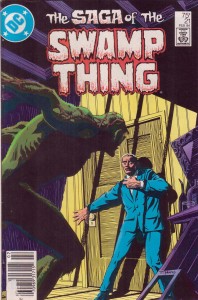
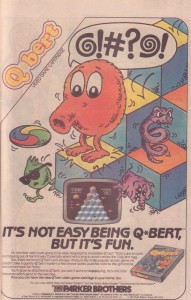
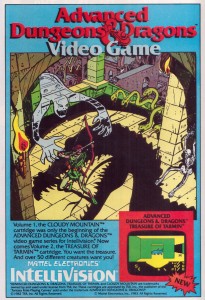
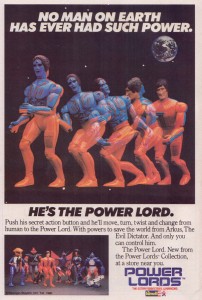
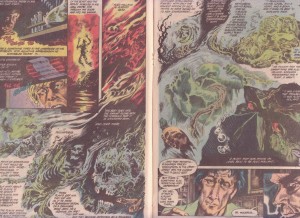
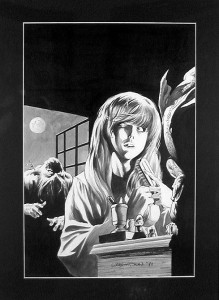
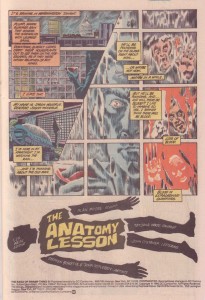
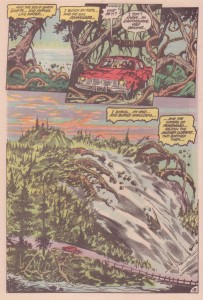
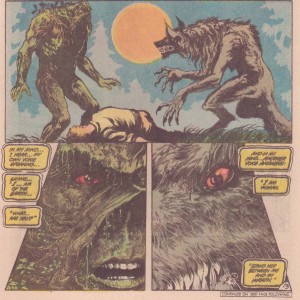
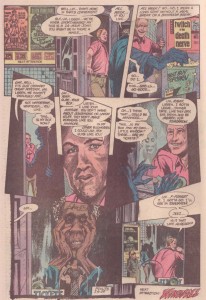
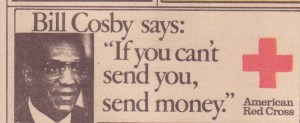
Well, Suat, we disagree again.
As far as continuing adventure comics series from the 80s and 90s go, I would rate Moore’s Swamp Thing second only Chaykin’s American Flagg! It’s certainly better than either the Miller/Janson Daredevil or Gaiman’s Sandman, which I would rate third and fourth.
“The Anatomy Lesson” is a very effectively developed suspense piece, the awful caption prose that opens it notwithstanding.
I’ve reviewed the entire run over at my own blog. Here are the links:
Book 1
Book 2
Book 3 & Book 4 (“American Gothic”)
Book 5 & Book 6
Suat’s not a huge fan of the Sandman run either.
I think for the next roundtable we need to deliberately set out to do a comic Suat likes. I don’t think we’ve hit on one yet!
Robert: I don’t disagree with you as to the series’ status. The series is immensely important as far as mainstream comics history is concerned. It certainly looms large in my memory, so large that I once bought a mediocre piece of art from the “American Gothic” storyline.
But really, this is second rate Moore and so much of it is silly and hamfisted. I was quite surprised at how poorly “American Gothic” read after a space of 2-3 decades. The toxic waste storyline in #35-36 was dreadful. All in all, vastly inferior to V for Vendetta which hails from the same period. In any case, most of the “breakthroughs” in comics during the 80s were occurring in the indies and mini-series format. That hasn’t changed much in the new millennium.
I think Cerebus (High Society and Church & State) may hold up better as well but I haven’t checked back in decades. I don’t know if Swamp Thing compares favorably with Sandman. I sometimes feel that Gaiman’s prose is more pleasing on the senses and the series as a whole is better planned.
Noah: Now you know why I’ve probably never used the words “great” or “genius” in relation to comics in my reviews. But Love and Rockets should do the trick – I like that.
Yeah….American Gothic is definitely the weakest storyline–esp. on rereading–although the last couple issues before the double-sized #50 almost make it worthwhile (48-49 I guess). I’d stand up for Anatomy Lesson and (esp.) Swamped though among the early issues. Swamped is still great. And the last year of the series remains one of the great 12 issue (or so) runs out there.
If you’d been reading regularly “your favorite monster magazine,” by this time you would have already picked up issue 20, which brims over with Moore’s intelligence and artistry. I never know why people refer to his run as starting at issue 21. (I mean, yes, that’s how it’s been reprinted, but as critics we should know better.)
Have you read the earlier (1-19) issues of SOTST? A lot of the tone that Moore uses comes from an attempt to continue smoothly the earlier part of the run. That really needs to be taken into account. Many of the things that people think Moore introduced were actually introduced by Marty Pasko (including many that account for the seemingly pretentious tone of the narration). It’s just that Moore did them better. Think of what Moore was presented with as an Oulipian constraint.
Also, I hope some of you will actually address the art here, including the b&w reprints of the early Moore/Bissette/Totleben issues, which are gorgeous.
I’d forgotten though Suat; you liked Ghost World. So we did hit one….
“The age of stupidity. The age of bad taste.”
But that’s every age, yes?
In fact, the Q-bert ad, the Ad&D ad, and even the Power Lords ad strike me as being fairly well-designed — certainly superior in layout and energy to the majority of mainstream super-hero work I’ve seen recently (a low bar, maybe, but still.) And that Anatomy Lesson first page is really nicely done…and the werewolf panels you put up there are some beautiful horror art. The extended limbs and posture of the wolf in particular manage to make her look really alien and animalistic — and I love the split screen, with the moon floating above, contrasting with the red eyes of the various protagonists.
I guess I agree with you in general that there’s a lot of silliness in these issues — but I think there’s also a lot of craft, and many great ideas (the woman as elemental is stupid — but the wolf body coming up through her throat and then shedding the woman’s skin is pretty bad ass.) I think maybe you’re just more or less completely uninterested in pulp at this point — which is a reasonable position, but leaves you kind of nowhere in terms of being able to appreciate the things Moore has to offer in this series. (And, of course, it’s not your fault that you’re reading it in the first place….)
Andrei: “If you’d been reading regularly “your favorite monster magazine,” by this time you would have already picked up issue 20, which brims over with Moore’s intelligence and artistry. I never know why people refer to his run as starting at issue 21.”
Well, let me help. No one actually thinks that #21 is the first issue. The reason why people always bring up issue 21 is because that’s the issue where Moore really begins to show his stuff together with Bissette and Totleben. Issue 20 may be the first issue by Moore and Totleben (as inker) but it’s still damage control. Over the years, Moore has been given a lot of credit for turning an awful title into the best DC had to offer. This doesn’t make it good, it just makes it better. It’s still years behind the best SF/Fantasy that had come out by that time. That’s why I agree with Eric when he says that the final issues of Swamp Thing were better (though probably not as important in the grand historical narrative of comics).
Noah: “I guess I agree with you in general that there’s a lot of silliness in these issues — but I think there’s also a lot of craft, and many great ideas (the woman as elemental is stupid — but the wolf body coming up through her throat and then shedding the woman’s skin is pretty bad ass.) I think maybe you’re just more or less completely uninterested in pulp at this point — which is a reasonable position, but leaves you kind of nowhere in terms of being able to appreciate the things Moore has to offer in this series. (And, of course, it’s not your fault that you’re reading it in the first place….)”
I have no arguments with the art by Bissette and Totleben. I especially like the latter. But you know more about the whole horror genre – wasn’t the wolf body coming out of throat thing done earlier in The Howling or An American Werewolf in London? Bissette is a real horror aficionado so maybe this was homage. I don’t know. I still like a lot of junk food/pulp. These early issues of Swamp Thing aren’t that fun though.
I”ve never seen the Howling or American Werewolf, believe it or not. Maybe Richard knows if it was a lift?
You didn’t think the Anatomy lesson was fun? I don’t know…it still seems pretty darn entertaining to me. I feel like the series was uneven, but definitely had its moments…
Nope – looks like I was wrong. Just checked on Youtube. Definitely not American Werewolf or The Howling. Got confused with the usual mouth into snout thing. Sui generis?
It’s actually a horror effect that I don’t know how they’d do in a film exactly; even with CGI it would probably end up looking dumb. Maybe a counter-example to Richard’s claims for the superiority of movie horror.
What pulp comics do you like? I haven’t hit on anything yet in talking to you, I don’t think….
That would depend on what you mean by a “pulp” comic. Since we’re talking specifically about the horror genre here, there were a few things which I liked in the Taboo anthology but I haven’t gone back to that in years. Also, Umezu Kazuo – The Drifting Classroom is way more fun than Swamp Thing.
I was actually going to bring up Drifting Classroom when the “can comics be scary?” discussion came up earlier this week- forgive me as I do so here. One of the things that wasn’t really brought up is once something is shown in a horror comic, the reader can look at it as long as she wishes, whereas in a film, not only is the monster lurking and often unseen, at least until the advent of DVD you couldn’t “capture” its image. Was Janet Leigh’s character actually stabbed on-screen in Psycho? Unless you had access to your own print and a movieola it was an academic question. Whereas in a comic, as soon as something is shown, it can be seen over and over, for as long and as often as someone can stand it. And that kind of exposure can rob an image of its mystery.
So, the Drifting Classroom was genuinely scary to me because it seemed up until the very end that truly anything was capable of happening, at any time. The fear in that case came from the unexpected, the fact that any of the characters could lose their lives at any time, and in truly horrific ways.
It’s hard for me to imagine any DC comic being scary or on the edge in that same way. Will Swamp Thing die? Well, let’s see here. Hasn’t he been optioned for a Saturday morning cartoon? So, probably not.
I think superhero and horror genres are really problematic together; superheroics is about sadism, horror is about masochism, and they really don’t work well when you try to merge them.
Drifting Classroom sounds pretty great. I need to get that.
wow, a brutal assessment of the series, and one that i have a real problem relating to. This series was such a distinct game changer in its day that it gains points for the sheer level of novelty that it has.
But beyond that, I have to both agree and disagree with some of the points brought up both in the review and in the comments section. Yes, issue #20 was damage control, but it was a fairly good triage when it comes down to it. Moore spends time at the end of #20 telling us that “there aren’t enough shadows for monsters to hide in anymore…” as a comment that the way horror had been done as a genre in comics wasn’t working, and puts the nail in the coffin with Swampy’s voice over, but then spends the next couple of years proving that it could be reinvented.
Anatomy lesson is a rather marvelous self contained issus that sets of the premise for a number of explorations, the first being the chance to take the pieces left behind from the original Wein run and the pasko issues (abby, matt, sunderland, arcane, etc) and twist them as far as they would go. His Norfulthing/Demon/Jason Blood trilogy before diving further into matt cable’s insanity is the best Demon we’ve ever seen. He makes jason blood both tragic and still scary at the same time.
Bissette and Totleben provide inventive artwork both at the layout and illustration stage. It doesn’t always work, but when it does its magnificent craft by two creators working rather feverishly to make a monthly book. You can’t ignore the level of growth that is seen in the first 7 or 8 issues, and neither of them would have been capable of doing the exquisite black and white work that shows up in the annual that caps the storyline. Against the blander (by editorial decree) work that marvel was putting out in the Jim Shooter era, there is no question that even without being perfect, the initial run of swampy #20- Annual #2 is one of my favorite runs from that decade.
Good points, Sean, but I wasn’t really scared by The Drifting Classroom. It’s certainly viciously grotesque and imaginative which are all plus points in horror as far as I’m concerned.
Be careful, Noah. That comic is filled with minors (elementary school kids and also the target audience) and a lot of them are horrendously abused. You might hate it. The first time I picked up one of his comics was in the mid-90s and I was stunned by the level of violence directed at children. I don’t think it’s been done in any mainstream stream series in the West.
Charles: I think you’ve more or less stated the traditional viewpoint on Moore’s achievement on Swamp Thing, one I would have accepted before rereading the first 20 issues over the last week or so. I have to say that Jason Blood didn’t seem particularly tragic in those issues. Matt Wagner did some readable stuff in his Demon mini-series as well.
“It’s hard for me to imagine any DC comic being scary or on the edge in that same way. Will Swamp Thing die? Well, let’s see here. Hasn’t he been optioned for a Saturday morning cartoon?”
What really doesn’t help is that right at the start of American Gothic, the big tour-the-horror-genre storyline, it’s established that Swamp Thing can switch from body to body and none of the beasties he encounters can hurt him. I think it’s telling that the minute Bissette leaves all the horror elements drop away and it becomes a full-on sci-fi/fantasy comic.
Suat: “Well, let me help. No one actually thinks that #21 is the first issue. The reason why people always bring up issue 21 is because that’s the issue where Moore really begins to show his stuff together with Bissette and Totleben. Issue 20 may be the first issue by Moore and Totleben (as inker) but it’s still damage control.”
Well, I guess you fooled me, the way you introduced it certainly did sound like you were presenting it as a first issue. In any case, your take is so general and at the same time negative that there is little to address directly. So I’ll just say this: if issue 20 is damage control, it’s excellent damage control, taking a narrative that had rolled up around itself and tripped on its own loose ends many times, and resolving it elegantly within one issue. Furthermore, the art (especially the use of extradiegetic elements in the frames) does things that may be at least as, if not more, interesting as anywhere else in the run. Overall, though, I think it’s more interesting to think of it–and of the entire series too–as Moore working, in a nearly Oulipian style, with a complex set of constraints: what can I do with this ridiculous, gothic backstory I’ve inherited? What can I do with the purple prose that Pasko has used to set the tone of the series? What can I do with the complex panel arrangements that by now were already a trademark of the run? This actually challenges Moore (almost never again will he work with such complex panel shapes, as it is much easier for him, as writer, to control the art if he works with a set grid), and I do think he creates the most successful work of his career. Left by himself, in total control of the stories he can tell, he ends up falling in the same rut (and that is true of “From Hell” much more than of SOST). Yes, the American Gothic stories are the weakest of the run, but I disagree about the earlier stories. And if you simply use to judge them a measuring stick of taking individual stories and setting them up against comparable sci fi or horror pieces, you are really missing the forest for the trees. Again, reading the entire run as, first of all, a conscious taking on of constraints, looking at the specific troping that Moore engages in (it’s always amazing to me, for example, that nobody ever mentions the totally obvious “Master and Margarita” reference, which is not only cute in a limited way, but connects the larger themes of the two works), and looking simultaneously at the wider ark and at individual details, pages where Moore really shows his artistry, seems to me the much more appropriate way to go.
Andrei: “…what can I do with this ridiculous, gothic backstory I’ve inherited? What can I do with the purple prose that Pasko has used to set the tone of the series? What can I do with the complex panel arrangements that by now were already a trademark of the run?…and looking simultaneously at the wider ark and at individual details, pages where Moore really shows his artistry, seems to me the much more appropriate way to go.”
Actually, the Master and Margarita connection has been mentioned in some articles online. I remember reading one anyway.
I have to say I much prefer reading nice things about Moore’s Swamp Thing than not, especially when the person writing says that it’s his favorite work by Moore. I’ll probably never agree since the “forest” for me will always be the overall effect of the story not the individual elements (working with artistic impediments, the formal tricks etc.). Moore’s stories are choked with ideas and there will always be things to grasp on to even if the tale fails to engage. There is some interesting shrubbery in these early issues of Swamp Thing but, quite simply put, Moore does not adequately surmount the obstacles. Viewing Moore’s run as an Oulipian enterprise won’t change that fact for me.
Noah should be posting a positive take on Swamp Thing in a few hours time.
The werewolf transformation (and indeed pretty much the rest of issue 40) is lifted from the Angela Carter / Neil Jordan film Company of Wolves. Check out the poster at imdb: http://www.imdb.com/media/rm126655488/tt0087075
Thank you for the attribution! The scene must have registered in my mind despite the intervening decades. Not a bad show, at least when seen through the eyes of a junior high student. That may have been because of all the half-naked women in it though…
No problem. I really really liked Company of Wolves when it came out. I especially liked the treatment of werewolves as scary and seductive gentlemen, with the turnabout that Little Red Riding Hood isn’t so little, but is a lot redder.
I remember being rather annoyed with Moore when ST #40 came out, as to how blatantly he’d lifted Carter, and lifted just the surface of it, so we get I AM WOMAN HEAR ME WOOF in place of Carter’s rather more layered and visceral take. It didn’t help that it came straight after those brilliant underwater vampires.
I’ve been waiting to say: I’m so glad you reproduced that page with The Anatomy Lesson titles: I knew I was going to love this thing the very instant I saw that page, because IT’S THE SAUL BASS ANATOMY OF A MURDER POSTER.
Which is, like, my favorite thing ever. Seriously.
Nostalgia ain’t just in comics. :-)
Indeed and almost a descendant of the poster art he did for Vertigo. I wonder who came up with the idea.